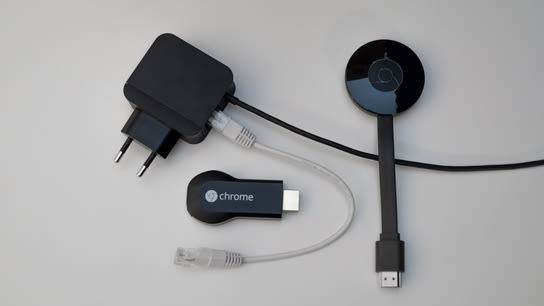There’s no easy way to identify whether your Google Chromecast is connected to your wired or wireless networks. The Chromecast doesn’t identify how it’s connected on its ready-screen nor from within its Android or iOS apps.
Assuming you’ve set up your Chromecast Ethernet Adapter, you may be wondering whether it’s working or not. There are no status lights on the adapter or Chromecast, nor are there any other indicators shown on screen or in the Cast app.
What you can do, however, is to look for the Chromecast’s MAC address on your network. The MAC address will identify what network interface (Ethernet or Wi-Fi) your Chromecast is connected to your local network. Unfortunately, Chromecast devices aren’t marked with their MAC addresses, unlike almost all other network equipment. There are still ways to discover their MAC addresses.
You can find the MAC address or your Chromecast’s Wi-Fi network interface from within the Google Cast app by going to Devices: Device Settings: Information. This will always show your Wi-Fi interface even though your Chromecast may be connected over Ethernet.
Next, we’ll figure out which MAC address your Chromecast is using.
-
- Windows: Open the Command Prompt program from the Start menu, type in the below command, and press Enter:
ping -n 1 chromecast - Linux/MacOS: Open the Terminal app from the Applications menu/Launchpad, type in the below command, and press Enter:
ping -c 1 chromecast
- Windows: Open the Command Prompt program from the Start menu, type in the below command, and press Enter:
- Type in the below command in Command Prompt/Terminal, and press Enter:
arp chromecast -
- Windows: Look for the IP address of your Chromecast as printed by the first command, and identify its Physical Address (MAC address) on the same line.
- Linux/MacOS: Look for the “
chromecast” hostname and identify the MAC address on the same line.
Note: Your Chromecast will identify itself on the network with the hostname “Chromecast” even if you’ve assigned it a customized display name. If you’ve multiple Chromecast devices in your network, you’ll need to disconnect them and wait at least five minutes before proceeding.
You may also find the MAC address in your router’s administration interface by looking for a section either called device list, network map, or DHCP leases. The exact instructions and naming will vary from router to router; please reference its manual for instructions.
Now that you’ve identified the MAC address that your Chromecast is using, you can use this information to identify how it’s connected to your network:
| Device | Network interface | MAC address prefix |
|---|---|---|
| Google Chromecast (2nd gen.) and Google Chromecast Audio |
Wi-Fi | 54:60:09 Google Inc. |
6C:AD:F8 AzureWave Technology Inc. |
||
| Google Chromecast (1st gen.) | Wi-Fi | D0:E7:82 AzureWave Technology Inc. |
| Google Ethernet Adapter for Chromecast | Ethernet | E8:C7:4F Liteon Technology Corp. |
00:E0:4C Realtek Semiconductor Corp. |
You can identify which Chromecast device you’ve thus:
- 1st generation: Stick with HDMI connector on one end and rounded on the other end.
- 2nd generation: Entirely round unit with an attached HDMI cable.
- Ethernet adapter: Looks like the normal power supply for Chromecast, but with an RJ-45 Ethernet connector at the base.
The MAC address you’re seeing indicates what interface your device is using to talk to the other devices on your network. Note that there may be some network information caching, so wait and try again in an hour if you’re surprised by the results you’re seeing.
Chromecast will attempt to connect to Wi-Fi after three minutes if the Ethernet cable is disconnected from the adapter, or it will connect to Wi-Fi immediately if there isn’t an Ethernet cable plugged in when the Chromecast is powered on. If you plug in an Ethernet adapter while you’re using it, the Chromecast will wait until its idle before attempting to switch from Wi-Fi to Ethernet. You can speed this up by unplugging it from power and reconnecting it.
I hope to see the Google Cast app add some kind of indicator in the future to make it a bit easier to determine how the Chromecast is connected to the network. It currently does show the device’s MAC address in the Settings section, so it wouldn’t be unprecedented to include such network information in the app.
